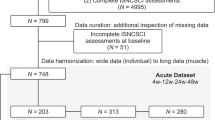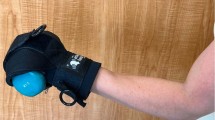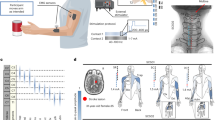Abstract
Study design
Retrospective cohort study.
Objectives
To quantify spontaneous upper extremity motor recovery between 6 and 12 months after spinal cord injury (SCI) to help guide timing of nerve transfer surgery to improve upper limb function in cervical SCI.
Setting
Nineteen European SCI rehabilitation centers.
Methods
Data was extracted from the European Multicenter Study of SCI database for individuals with mid-level cervical SCI (N = 268). Muscle function grades at 6 and 12 months post-SCI were categorized for analysis.
Results
From 6 to 12 months after SCI, spontaneous surgically-relevant recovery was limited. Of all limbs (N = 263) with grade 0–2 elbow extension at 6 months, 4% regained grade 4–5 and 11% regained grade 3 muscle function at 12 months. Of all limbs (N = 380) with grade 0–2 finger flexion at 6 months, 3% regained grade 4–5 and 5% regained grade 3 muscle function at 12 months.
Conclusion
This information supports early (6 month) post-injury surgical consultation and evaluation. With this information, individuals with SCI can more fully engage in preference-based decision-making about surgical intervention versus continued rehabilitation and spontaneous recovery to gain elbow extension and/or hand opening and closing.
Similar content being viewed by others
Log in or create a free account to read this content
Gain free access to this article, as well as selected content from this journal and more on nature.com
or
Data availability
The dataset generated and/or analysed during the current study is available from the corresponding author.
References
Hentz VR, Leclercq C. Surgical rehabilitation of the upper limb in tetraplegia. London, England: W.B. Saunders; 2002.
Hill EJR, Fox IK. Current best peripheral nerve transfers for spinal cord injury. Plast Reconstr Surg. 2019;143:184e–198e.
van Zyl N, Hill B, Cooper C, Hahn J, Galea MP. Expanding traditional tendon-based techniques with nerve transfers for the restoration of upper limb function in tetraplegia: A prospective case series. Lancet 2019;394:565–75.
Coulet B, Allieu Y, Chammas M. Injured metamere and functional surgery of the tetraplegic upper limb. Hand Clin. 2002;18:399–412.
Fox IK, Novak CB, Krauss EM, Hoben GM, Zaidman CM, Ruvinskaya R, et al. The use of nerve transfers to restore upper extremity function in cervical spinal cord injury. PM R 2018;10:1173–84e1172.
Berger MJ, Robinson L, Krauss EM. Lower motor neuron abnormality in chronic cervical spinal cord injury: Implications for nerve transfer surgery. J Neurotrauma. 2022;39:259–65.
Fu SY, Gordon T. Contributing factors to poor functional recovery after delayed nerve repair: Prolonged denervation. J Neurosci. 1995;15:3886–95.
Waters RL, Adkins RH, Yakura JS, Sie I. Motor and sensory recovery following complete tetraplegia. Arch Phys Med Rehabil. 1993;74:242–7.
Waters RL, Adkins RH, Yakura JS, Sie I. Motor and sensory recovery following incomplete tetraplegia. Arch Phys Med Rehabil. 1994;75:306–11.
Raineteau O, Schwab ME. Plasticity of motor systems after incomplete spinal cord injury. Nat Rev Neurosci. 2001;2:263–73.
Curt A, Van Hedel HJ, Klaus D, Dietz V, Group, SS E-. Recovery from a spinal cord injury: Significance of compensation, neural plasticity, and repair. J Neurotrauma. 2008;25:677–85.
Ditunno JF Jr., Cohen ME, Hauck WW, Jackson AB, Sipski ML. Recovery of upper-extremity strength in complete and incomplete tetraplegia: A multicenter study. Arch Phys Med Rehabil. 2000;81:389–93.
Steeves JD, Kramer JK, Fawcett JW, Cragg J, Lammertse DP, Blight AR, et al. Extent of spontaneous motor recovery after traumatic cervical sensorimotor complete spinal cord injury. Spinal Cord. 2011;49:257–65.
Kirshblum SC, Biering-Sorensen F, Betz R, Burns S, Donovan W, Graves DE, et al. International standards for neurological classification of spinal cord injury: Cases with classification challenges. J Spinal Cord Med 2014;37:120–7.
Cain SA, Gohritz A, Friden J, van Zyl N. Review of upper extremity nerve transfer in cervical spinal cord injury. J Brachial Plex Peripher Nerve Inj. 2015;10:e34–e42.
Kobayashi J, Mackinnon SE, Watanabe O, Ball DJ, Gu XM, Hunter DA, et al. The effect of duration of muscle denervation on functional recovery in the rat model. Muscle Nerve. 1997;20:858–66.
Mackinnon SE, Novak CB. Nerve transfers. New options for reconstruction following nerve injury. Hand Clin. 1999;15:643–66.
Gordon T, Yang JF, Ayer K, Stein RB, Tyreman N. Recovery potential of muscle after partial denervation: A comparison between rats and humans. Brain Res Bull. 1993;30:477–82.
Bertelli JA, Ghizoni MF. Nerve transfers for restoration of finger flexion in patients with tetraplegia. J Neurosurg Spine. 2017;26:55–61.
Bertelli JA, Ghizoni MF. Nerve transfers for elbow and finger extension reconstruction in midcervical spinal cord injuries. J Neurosurg. 2015;122:121–7.
Khalifeh JM, Dibble CF, Van Voorhis A, Doering M, Boyer MI, Mahan MA, et al. Nerve transfers in the upper extremity following cervical spinal cord injury. Part 2: Preliminary results of a prospective clinical trial. J Neurosurg Spine. 2019;31:641–53.
Khalifeh JM, Dibble CF, Van Voorhis A, Doering M, Boyer MI, Mahan MA, et al. Nerve transfers in the upper extremity following cervical spinal cord injury. Part 1: Systematic review of the literature. J Neurosurg Spine. 2019;31:629–40.
Fox IK, Davidge KM, Novak CB, Hoben G, Kahn LC, Juknis N, et al. Use of peripheral nerve transfers in tetraplegia: evaluation of feasibility and morbidity. Hand (N.Y). 2015;10:60–7.
L‘Hotta AJ, James AS, Curtin CM, Kennedy C, Kenney D, Tam K, et al. Surgery to Restore Upper Extremity Function in Tetraplegia—Preferences for Early and Frequent Access to Information. PM&R: The Journal of Injury, Function and Rehabilitation. Accepted for publication. https://doi.org/10.1002/pmrj.12862.
Jain NS, Hill EJR, Zaidman CM, Novak CB, Hunter DA, Juknis N, et al. Evaluation for late nerve transfer surgery in spinal cord injury: Predicting the degree of lower motor neuron injury. J Hand Surg Am. 2020;45:95–103.
Fox IK, Novak CB, Kahn LC, Mackinnon SE, Ruvinskaya R, Juknis N. Using nerve transfer to restore prehension and grasp 12 years following spinal cord injury: a case report. Spinal Cord Ser Cases. 2018;4:37.
Ziaziaris WA, Ahadi MS, Gill AJ, Ledgard JP. The anatomy of nerve transfers used in tetraplegic hand reconstruction. J Hand Surg Am. 2021, advance online publication. https://doi.org/10.1016/j.jhsa.2021.09.003.
Friden J, Gohritz A. Brachialis-to-extensor carpi radialis longus selective nerve transfer to restore wrist extension in tetraplegia: Case report. J Hand Surg Am. 2012;37:1606–8.
Fox IK, Miller AK, Curtin CM. Nerve and tendon transfer surgery in cervical spinal cord injury: Individualized choices to optimize function. Top Spinal Cord Inj Rehabil. 2018;24:275–87.
Titolo P, Fusini F, Arrigoni C, Isoardo G, Conforti L, Artiaco S, et al. Combining nerve and tendon transfers in tetraplegia: A proposal of a new surgical strategy based on literature review. Eur J Orthop Surg Traumatol. 2019;29:521–30.
Grassner L, Wutte C, Klein B, Mach O, Riesner S, Panzer S, et al. Early Decompression (<8 h) after traumatic cervical spinal cord injury improves functional outcome as assessed by spinal cord independence measure after one year. J Neurotrauma. 2016;33:1658–66.
Denis AR, Feldman D, Thompson C, Mac-Thiong JM. Prediction of functional recovery six months following traumatic spinal cord injury during acute care hospitalization. J Spinal Cord Med. 2018;41:309–17.
Jaja BNR, Badhiwala J, Guest J, Harrop J, Shaffrey C, Boakye M, et al. Trajectory-based classification of recovery in sensorimotor complete traumatic cervical spinal cord injury. Neurology. 2021; 96:e2736–48.
Wilson JR, Davis AM, Kulkarni AV, Kiss A, Frankowski RF, Grossman RG, et al. Defining age-related differences in outcome after traumatic spinal cord injury: analysis of a combined, multicenter dataset. The spine journal: Official journal of the North American Spine. Society 2014;14:1192–8.
Whiteneck G, Meade MA, Dijkers M, Tate DG, Bushnik T, Forchheimer MB. Environmental factors and their role in participation and life satisfaction after spinal cord injury. Arch Phys Med Rehabilitation. 2004;85:1793–803.
Mooney A, Hewitt AE, Hahn J. Nothing to lose: A phenomenological study of upper limb nerve transfer surgery for individuals with tetraplegia. Disabil Rehabil. 2021;43:3748–56.
Fox I, Hoben G, Komaie G, Novak C, Hamm R, Kahn L, et al. Nerve transfer surgery in cervical spinal cord injury: A qualitative study exploring surgical and caregiver participant experiences. Disabil Rehabilitation. 2021;43:1542–9.
Kirshblum S, Millis S, McKinley W, Tulsky D. Late neurologic recovery after traumatic spinal cord injury. Arch Phys Med Rehabil. 2004;85:1811–7.
Acknowledgements
Amanda Miller, MD provided advice on clinically relevant information.
Funding
This work was supported by the Department of Defense-W81XWH-17-1-0285 Supporting Patient Decisions about Upper-Extremity Surgery in Cervical SCI (PI: Ida K. Fox). The contents of this work do not represent the views of the U.S. Department of Veterans Affairs or the United States Government.
Author information
Authors and Affiliations
Consortia
Contributions
JD was responsible for study design, extracting and analyzing the data, interpreting the results and writing the report. JDS was responsible for study design, interpreting the results and editing the report. AC was responsible for interpreting the results and providing feedback on the report. MM was responsible for extracting and analyzing the data, and providing feedback on the report. CBN was responsible for study design and providing feedback on the report. IKF was responsible for study design, interpreting the results and writing the report. CC, CK, DO and KCS were responsible for study design and providing feedback on the report. DO, RA, NW, RR, JV, JB and YBK were responsible for data collection and providing feedback on the report.
Corresponding author
Ethics declarations
Competing interests
The authors declare no competing interests.
Additional information
Publisher’s note Springer Nature remains neutral with regard to jurisdictional claims in published maps and institutional affiliations.
Supplementary information
Rights and permissions
Springer Nature or its licensor holds exclusive rights to this article under a publishing agreement with the author(s) or other rightsholder(s); author self-archiving of the accepted manuscript version of this article is solely governed by the terms of such publishing agreement and applicable law.
About this article
Cite this article
Dengler, J., Steeves, J.D., Curt, A. et al. Spontaneous Motor Recovery after Cervical Spinal Cord Injury: Issues for Nerve Transfer Surgery Decision Making. Spinal Cord 60, 922–927 (2022). https://doi.org/10.1038/s41393-022-00834-6
Received:
Revised:
Accepted:
Published:
Issue date:
DOI: https://doi.org/10.1038/s41393-022-00834-6
This article is cited by
-
Chirurgische Rekonstruktion der Arm- und Handfunktion bei Tetraplegie
Die Unfallchirurgie (2023)



